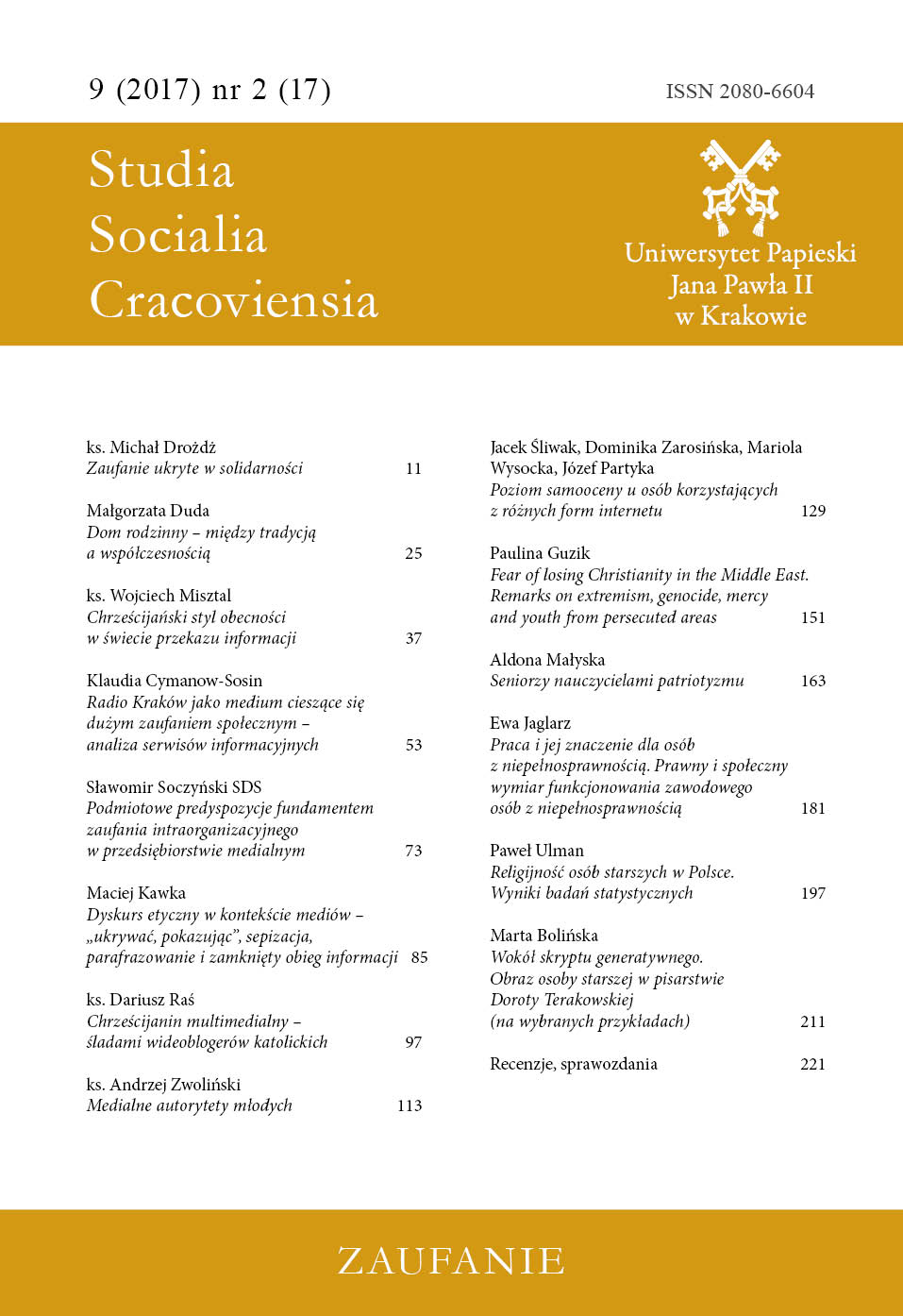Poziom samooceny u osób korzystających z różnych form internetu
DOI:
https://doi.org/10.15633/ssc.2460Słowa kluczowe:
internet, samoocena, psychologia mediów, media społecznościowe, etyka mediówAbstrakt
Poziom samooceny u osób korzystających z różnych form internetu. Celem niniejszego opracowania jest zbadanie zależności między samooceną internautów a korzystaniem przez nich z internetu. Zagadnienie podjęto ze względu na jego aktualność. Internet i jego zasoby przyciągają uwagę większości ludzi z różnych grup wiekowych. Grupę badaną stanowiło 120 osób, spośród których 98 ma konto na portalach społecznościowych. W badaniach posłużono się Wielowymiarowym Kwestionariuszem Samooceny MSEI (służącym do badania samooceny) oraz skonstruowanym na potrzeby pracy kwestionariuszem dotyczącym korzystania z różnych form internetu. Analiza wyników nie wykazała istotnych statystycznie zależności między ogólnym poziomem samooceny a częstotliwością korzystania z internetu. Związki zauważono jednak między niektórymi wymiarami samooceny a czasem korzystania z sieci. Odkryto też korelacje istotne statystycznie między oceną własnych zdolności przywódczych a aktywnością na portalach społecznościowych.
Bibliografia
Barrie J. M., Presti D. E., The World Wide Web as an instructional tool, „Science” 274 (1996) 5286, s. 371–373, doi: 10.1126/science.274.5286.371.
Baumeister R. F., Tice D. M., Point-counterpoints: Anxiety and social exclusion, „Journal of Social and Clinical Psychology” 9 (1990) 2, s. 165–195.
Bendyk E., Wstęp, w: YouTube. Wideo online a kultura uczestnictwa, red. J. Burgess, J. Green, T. Płudowski, Warszawa 2011, s. 7–15.
Bloom B. S., Iannacone R. C., Internet availability of prescription pharmaceuticals to the public, „Annals of Internal Medicine” 131 (1999) 11, s. 830–833.
Całe życie w Sieci, red. B. Szmigielska, Kraków 2008.
Centrum Badania Opinii Społecznej, Internauci 2015. Komunikat z badań CBOS, Warszawa 2015.
Drożdż M., Człowiek w sieci, w: Internet światem człowieka, red. M. Drożdż, J. Smoleń, Kraków 2009, s. 13–22.
Epstein S., The self-concept: A review and the proposal of an integrated theory of personality, w: Personality. Basic aspects and current research, ed. E. Staub, Prentice-Hall 1980, s. 81–132.
Fecenec D., Wielowymiarowy kwestionariusz samooceny: MSEI: polska adaptacja: podręcznik, Warszawa 2008.
Gromkowska-Melosik A., Cyber-kobieta, czyli o wirtualnych symulacjach istnienia, w: Kultura popularna i (re) konstrukcje tożsamość, red. A. Gromkowska-Melosik, 2007, s. 268–306.
Hordecki B., Aksjologia Internetu, w: Oblicza Internetu. Internet jako przestrzeń komunikacji i dialogu, red. M. Sokołowski, Elbląg 2012, s. 15–26.
Internetowa Encyklopedia PWN, http://encyklopedia.pwn.pl/haslo/Internet;3915155.html (13.05.2017).
Kalichman S. C., Weinhardt L., Benotsch E., DiFonzo K., Luke W., Austin J., Internet access and internet use for health information among people living with HIV–AIDS, „Patient Education and Counseling” 46 (2002) 2, s. 109–116.
Katz J. E., Rice R. E., Aspden P., The Internet, 1995–2000: Access, civic involvement, and social interaction, „American Behavioral Scientist” (45) (2001) 3, s. 405–419.
Kiang M. Y., Raghu T. S., Shang K. Huei-Min, Marketing on the Internet – who can benefit from an online marketing approach?, „Decision Support Systems” 27 (2000) 4, s. 383–393.
Koc-Kozłowiec B., Zachowania komunikacyjne użytkowników Facebooka, w: Oblicza Internetu. Opus Universale. Kulturowe, edukacyjne i technologiczne przestrzenie Internetu, red. M. Sokołowski, Elbląg 2008, s. 121–135.
Leary M. R., Downs D. L., Tambor E. S., Terdal S. K., Self-esteem as an interpersonal monitor: The sociometer hypothesis, w: The self in social psychology, ed. R. F. Baumeister, Philadelphia, Pa., 1999.
Leary M. R., Making sense of self-esteem, „Current Directions in Psychological Science” 8 (1999) 1, s. 32–35.
Lynch D. C., Lundquist L., Digital money: The new era of Internet commerce, New York 1996.
Mehdizadeh S., Self-presentation 2.0: Narcissism and self-esteem on Facebook, „Cyberpsychology, Behavior, and Social Networking” 13 (2010) 4, s. 357–364.
Personality. Basic aspects and current research, ed. E. Staub, Prentice-Hall 1980.
Poon S., Joseph M., A preliminary study of product nature and electronic commerce, „Marketing Intelligence & Planning” 19 (2001) 7, s. 493–500.
Pytlakowska K., Gomuła J., Lem S., Zaczatowani, Warszawa 2005.
Pyżalski J., Agresja elektroniczna i cyberbullying jako nowe ryzykowne zachowania młodzieży, Kraków 2012.
Robak M., Internet – od nowego medium do sieci społecznej, w: Internet a relacje międzyludzkie, red. E. Laskowska, M. Kuciński, Bydgoszcz 2010 s. 9–18.
Senol-Durak E., Durak M., The mediator roles of life satisfaction and self-esteem between the affective components of psychological well-being and the cognitive symptoms of problematic Internet use, „Social Indicators Research” 103 (2011) 1, s. 23–32.
Sobol-Kwapińska M., Kwestionariusz Metafory Czasu. KMC podręcznik, Warszawa 2008.
Suchacka M., Nostalgia w sieci, czyli o budzeniu sentymentów w społeczeństwie informacyjnym na przykładzie portal społecznościowego, w: Oblicza Internetu. Opus Universale. Kulturowe, edukacyjne i technologiczne przestrzenie Internetu, red. M. Sokołowski, Elbląg 2008, s. 157–161.
Szmigielska B., Rola Internetu w biegu życia ludzkiego, w: red. B. Szmigielska, Całe życie w Sieci, Kraków 2008, s. 7–18.
Ślęzak I., Seks i erotyka w sieci, czyli czego poszukują internauci, w: Oblicza Internetu. Opus Universale. Kulturowe, edukacyjne i technologiczne przestrzenie Internetu, red. M. Sokołowski, Elbląg 2008, s. 145–153.
The self in social psychology, ed. R. F. Baumeister, Philadelphia, Pa., 1999.
YouTube. Wideo online a kultura uczestnictwa, red. J. Burgess, J. Green, T. Płudowski, Warszawa 2011.
Pobrania
Opublikowane
Numer
Dział
Licencja
Autorzy publikujący w czasopiśmie udzielają jego wydawcy zgody o następującej treści:
- Autor zachowuje autorskie prawa majątkowe do utworu, a jednocześnie udziela wydawcy czasopisma zgody na jego pierwszą publikację w wersji drukowanej i wersji online na licencji Creative Commons Uznanie autorstwa 4.0 Międzynarodowe oraz zgody na wykonywanie opracowań, w tym przekładów.
- Autor ma możliwość udzielania zgody niewyłącznej na opublikowanie utworu w wersji, która ukazała się w czasopiśmie (np. zamieszczenia go w repozytorium instytucjonalnym lub opublikowania w książce), wraz z informacją o jego pierwszej publikacji w czasopiśmie.
- Autor może umieścić swój utwór online (np. w repozytorium instytucjonalnym lub na swojej stronie internetowej) jeszcze przed zgłoszeniem utworu do czasopisma.

